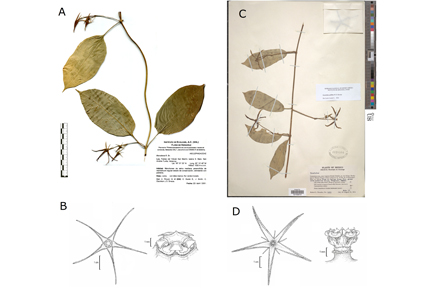Abstract
Gonolobus sanmartinus is herein described and illustrated from the state of Veracruz, Mexico. It is an endemic species to the Los Tuxtlas region and similar in foliar features to those of G. pallidus. However, the faucial ring and gynostegial corona are remarkably different. This new species shares its distribution with G. ancorifer, G. fraternus, G. niger and G. versicolor, and a dichotomous identification key for these species in the Los Tuxtlas region is included. The new species’ relationship with other species is discussed and a geographic distribution map is presented, as well as its conservation status.
References
- Alvarado-Cárdenas, L.O., Lozada-Pérez, L., Islas-Hernández, C.S., Cortez-Castro, E.B., Maya-Mandujano, K. & Chávez-Hernández, M.G. (2020) Apocináceas de ayer y hoy. Conocimiento histórico y reevaluación de la diversidad de Apocynaceae en México. Botanical Sciences 98 (2): 377–400. https://doi.org/10.17129/botsci.2525
- Bachman, S., Moat, J., Hill, A., de la Torre, J. & Scott, B. (2011) Supporting Red List threat assessments with GeoCAT: Geospatial Conservation Assessment Tool. ZooKeys 150: 117–126. https://doi.org/10.3897/zookeys.150.2109
- Cavanilles, A.J. (1793) Icones et descriptiones plantarum, quae aut sponte in Hispanica crescuntaut in hortis hospitantur. Vol. II. Ex Regia Typographia. Madrid. 83 pp.
- de Queiroz, K. (2007) Species concepts and species delimitation. Systematic biology 56: 879–886. https://doi.org/10.1080/10635150701701083
- Dirzo, R. & García, M.C. (1992) Rates of deforestation in Los Tuxtlas, a neotropical area in Southeast Mexico. Conservation Biology. 6: 84–90. https://doi.org/10.1046/j.1523-1739.1992.610084.x
- Hernández-Barón, G.M., Juárez-Jaimes, V. & Campos-Villanueva, Á. (2019) La subfamilia Asclepiadoideae (Apocynaceae) de la región de Los Tuxtlas, Veracruz, México. Revista Mexicana de Biodiversidad 90: e902897. https://doi.org/10.22201/ib.20078706e.2019.90.2897
- Ibarra-Manríquez, G. & Sinaca, S. (1987) Lista florística de la Estación de Biología Tropical Los Tuxtlas. In: Listados Florísticos de México VII. Instituto de Biología, Universidad Nacional Autónoma de México. 51 pp.
- IUCN (2022) The IUCN Red List of Threatened Species. Version 2022-1. Available from: https://www.iucnredlist.org (accessed 23 August 2022).
- JSTOR Global Plants (2023) Available from: https://plants.jstor.org/ (23 August 2022).
- Juárez-Jaimes, V., Alvarado-Cárdenas, L.O. & Villaseñor, J.L. (2007) La familia Apocynaceae sensu lato en México: diversidad y distribución. Revista Mexicana de Biodiversidad 78: 459‒482. https://doi.org/10.22201/ib.20078706e.2007.002.402
- Michaux, A. (1803) Flora boreali-americana: sistens caracteres plantarum quas in America septentrionali collegit et detexit Andreas Michaux. Levrault, Paris, pp. 119. https://doi.org/10.5962/bhl.title.330
- QGIS Development Team. (2020) QGIS Geographic Information System. Open Source Geospatial Foundation Project. Available from: https://qgis.org/es/site/ (accessed 7 September 2023)
- Schlechtendal, D.F.L. (1833) De Plantis Mexicanis. Linnaea 8 (5): 513–528.
- Schultes, J.A. (1820) Systema Vegetabilium: secundum classes, ordines, genera, species cum characteribus differentiis et synonymis. Editio nova, speciebus inde ab editione XV. Detectis aucta et locupletata. Stuttgardtiae. pp. 61.
- Stevens, W.D. & Montiel, O.M. (2002) A New Species of Gonolobus (Apocynaceae, Asclepiadoideae) from Mesoamerica. Novon 12 (4): 551‒554. https://doi.org/10.2307/3393138
- Stevens, W.D. (2005) Fourteen new species of Gonolobus (Apocynaceae, Asclepiadoideae) from Mexico and Central America. Novon 15 (1): 222‒244. [https://www.jstor.org/stable/3393422]
- Stevens, W.D. (2009) Apocynaceae. In: Davidse, G., Sousa, M., Knapp, S. & Chiang, F. (Eds.) Flora Mesoamericana. Vol. 4, parte 1. Universidad Nacional Autónoma de México, Missouri Botanical Garden, The Natural History Museum (London), pp. 733–741.
- Thiers, B.M. (2023 [updated continuously]) Index Herbariorum. Available from: http://sweetgum.nybg.org/science/ih/ (accessed 7 September 2023)
- Villaseñor, J.L., Ortiz, E. & Campos-Villanueva, Á. (2018) High Richness of Vascular Plants in the Tropical Los Tuxtlas Region, Mexico. Tropical Conservation Science 2: 1–12. https://doi.org/10.1177/1940082918764259
- Woodson, Jr., R.E. (1944) Studies of Central American plants–IV. In: Standley, P.C. & Steyermark, J.A. Publications of the Field Museum of Natural History, Botanical Series 23 (2): 31–109.


